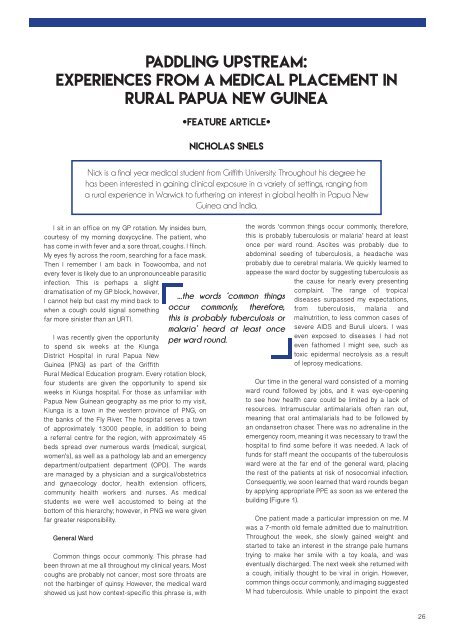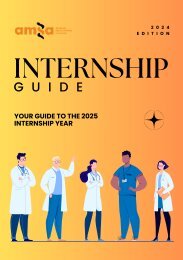Vector Volume 11 Issue 2 - 2017
Create successful ePaper yourself
Turn your PDF publications into a flip-book with our unique Google optimized e-Paper software.
Paddling upstream:<br />
Experiences from a medical placement in<br />
rural Papua New Guinea<br />
[Feature Article]<br />
Nicholas Snels<br />
I sit in an office on my GP rotation. My insides burn,<br />
courtesy of my morning doxycycline. The patient, who<br />
has come in with fever and a sore throat, coughs. I flinch.<br />
My eyes fly across the room, searching for a face mask.<br />
Then I remember I am back in Toowoomba, and not<br />
every fever is likely due to an unpronounceable parasitic<br />
infection. This is perhaps a slight<br />
dramatisation of my GP block, however,<br />
I cannot help but cast my mind back to<br />
when a cough could signal something<br />
far more sinister than an URTI.<br />
I was recently given the opportunity<br />
to spend six weeks at the Kiunga<br />
District Hospital in rural Papua New<br />
Guinea (PNG) as part of the Griffith<br />
Rural Medical Education program. Every rotation block,<br />
four students are given the opportunity to spend six<br />
weeks in Kiunga hospital. For those as unfamiliar with<br />
Papua New Guinean geography as me prior to my visit,<br />
Kiunga is a town in the western province of PNG, on<br />
the banks of the Fly River. The hospital serves a town<br />
of approximately 13000 people, in addition to being<br />
a referral centre for the region, with approximately 45<br />
beds spread over numerous wards (medical, surgical,<br />
women’s), as well as a pathology lab and an emergency<br />
department/outpatient department (OPD). The wards<br />
are managed by a physician and a surgical/obstetrics<br />
and gynaecology doctor, health extension officers,<br />
community health workers and nurses. As medical<br />
students we were well accustomed to being at the<br />
bottom of this hierarchy; however, in PNG we were given<br />
far greater responsibility.<br />
General Ward<br />
Nick is a final year medical student from Griffith University. Throughout his degree he<br />
has been interested in gaining clinical exposure in a variety of settings, ranging from<br />
a rural experience in Warwick to furthering an interest in global health in Papua New<br />
Guinea and India.<br />
Common things occur commonly. This phrase had<br />
been thrown at me all throughout my clinical years. Most<br />
coughs are probably not cancer, most sore throats are<br />
not the harbinger of quinsy. However, the medical ward<br />
showed us just how context-specific this phrase is, with<br />
...the words ‘common things<br />
occur commonly, therefore,<br />
this is probably tuberculosis or<br />
malaria’ heard at least once<br />
per ward round.<br />
the words ‘common things occur commonly, therefore,<br />
this is probably tuberculosis or malaria’ heard at least<br />
once per ward round. Ascites was probably due to<br />
abdominal seeding of tuberculosis, a headache was<br />
probably due to cerebral malaria. We quickly learned to<br />
appease the ward doctor by suggesting tuberculosis as<br />
the cause for nearly every presenting<br />
complaint. The range of tropical<br />
diseases surpassed my expectations,<br />
from tuberculosis, malaria and<br />
malnutrition, to less common cases of<br />
severe AIDS and Buruli ulcers. I was<br />
even exposed to diseases I had not<br />
even fathomed I might see, such as<br />
toxic epidermal necrolysis as a result<br />
of leprosy medications.<br />
Our time in the general ward consisted of a morning<br />
ward round followed by jobs, and it was eye-opening<br />
to see how health care could be limited by a lack of<br />
resources. Intramuscular antimalarials often ran out,<br />
meaning that oral antimalarials had to be followed by<br />
an ondansetron chaser. There was no adrenaline in the<br />
emergency room, meaning it was necessary to trawl the<br />
hospital to find some before it was needed. A lack of<br />
funds for staff meant the occupants of the tuberculosis<br />
ward were at the far end of the general ward, placing<br />
the rest of the patients at risk of nosocomial infection.<br />
Consequently, we soon learned that ward rounds began<br />
by applying appropriate PPE as soon as we entered the<br />
building (Figure 1).<br />
One patient made a particular impression on me. M<br />
was a 7-month old female admitted due to malnutrition.<br />
Throughout the week, she slowly gained weight and<br />
started to take an interest in the strange pale humans<br />
trying to make her smile with a toy koala, and was<br />
eventually discharged. The next week she returned with<br />
a cough, initially thought to be viral in origin. However,<br />
common things occur commonly, and imaging suggested<br />
M had tuberculosis. While unable to pinpoint the exact<br />
26

















